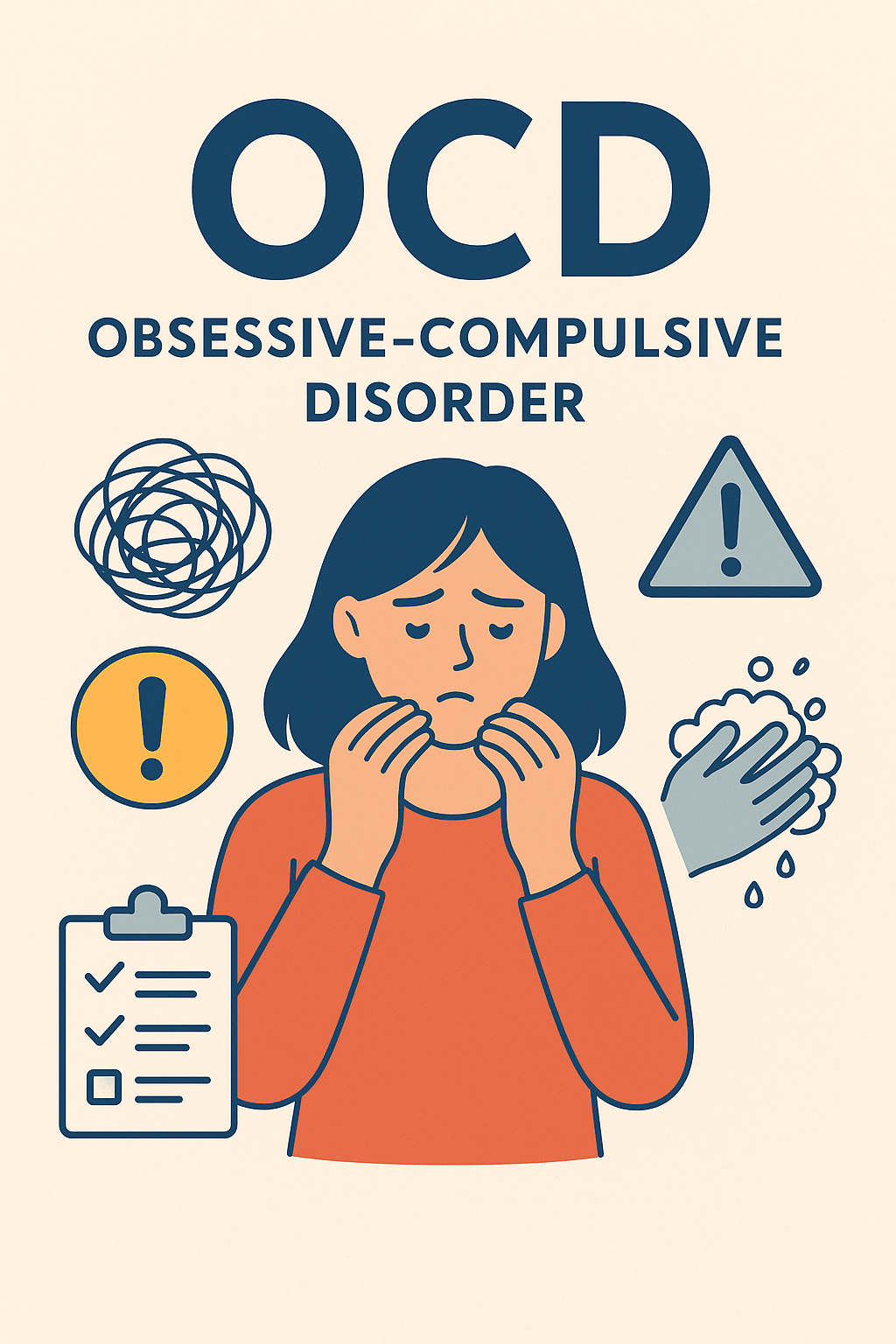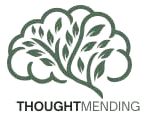
Obsessive-Compulsive Disorder is a common, chronic, and long-lasting disorder in which a person has uncontrollable, recurring thoughts (obsessions) and/or behaviors (compulsions) that a person feels the urge to repeat over and over.
Diagnostic Criteria for Obsessive-Compulsive Disorder
A. Presence of obsessions, compulsions, or both:
Obsessions are defined by (1) and (2):
1. Most individuals experience recurrent and persistent thoughts, urges, or impulses as intrusive and unwanted, which cause marked anxiety or distress during the disturbance
2. The individual attempts to ignore or suppress such thoughts, urges, or images, or to neutralize them with some other thought or action (i.e., by performing a compulsion).
Compulsions are defined by (1) and (2):
1. Individuals feel driven to perform repetitive behaviors (e.g., hand washing, ordering, checking) or mental acts (e.g., praying, counting, repeating words silently) in response to an obsession or rigid rules.
2. Clinicians do not explain the disturbance as part of another mental disorder. They rule out excessive worries in generalized anxiety disorder, appearance concerns in body dysmorphic disorder, or difficulty discarding possessions in hoarding disorder. Moreover, patients also exhibit hair pulling in trichotillomania, skin picking in excoriation disorder, stereotypies in stereotypic movement disorder, and ritualized eating in eating disorders. Abd, rule out preoccupation with substances or gambling in addictive disorders, illness anxiety, sexual urges in paraphilic disorders, and impulses in impulse-control disorders. They also exclude guilty ruminations in major depression, delusional preoccupations in psychotic disorders, and repetitive behaviors in autism spectrum disorder
Note: Young children may not be able to articulate the aims of these behaviors or mental acts.
B. The obsessions or compulsions are time-consuming (e.g., take more than 1 hour per day) or cause clinically significant distress or impairment in social, occupational, or other important areas of functioning.
C. The obsessive-compulsive symptoms are not attributable to the physiological effects of a substance (e.g., a drug of abuse, a medication) or another medical condition.
D.Another mental disorder does not better explain the disturbance. Examples include excessive worries in generalized anxiety disorder, preoccupation with appearance in body dysmorphic disorder, or difficulty discarding possessions in hoarding disorder. It also excludes hair pulling in trichotillomania, skin picking in excoriation disorder, stereotypies in stereotypic movement disorder, and ritualized eating in eating disorders. Similarly, it does not result from preoccupation with substances or gambling, illness anxiety, sexual urges in paraphilic disorders, impulses in impulse-control disorders, guilty ruminations in depression, delusional preoccupations in psychotic disorders, or repetitive behaviors in autism spectrum disorder
Specify if:
With good or fair insight:
The individual recognizes that obsessive-compulsive disorder beliefs are definitely or probably not true or that they may or may not be true.
With poor insight:
The individual thinks obsessive-compulsive disorder beliefs are probably true.
With absent insight/delusional beliefs:
The individual is completely convinced that obsessive-compulsive disorder beliefs are true.
Symptoms of OCD
People with OCD may have symptoms of obsessions, compulsions, or both. These symptoms can significantly impact all aspects of life, including work, school, and personal relationships.
Obsessions are repeated thoughts, urges, or mental images that cause anxiety. Common symptoms include:
- Fear of germs or contamination
- Unwanted, forbidden, or taboo thoughts involving sex, religion, or harm
- Aggressive thoughts towards others or self
- Having things symmetrical or in perfect order
Compulsions are repetitive behaviors that a person with OCD feels the urge to do in response to an obsessive thought. Common compulsions include:
- Excessive cleaning and/or handwashing
- Ordering and arranging things in a particular, precise way
- Repeatedly checking on things, such as repeatedly checking to see if the door is locked or that the oven is off
- Compulsive counting
Not all rituals or habits are compulsions. Everyone double-checks things sometimes. But a person with OCD generally:
- Can’t control his or her thoughts or behaviors, even when those thoughts or behaviors are recognized as excessive
- Spends at least 1 hour a day on these thoughts or behaviors
- Doesn’t get pleasure when performing the behaviors or rituals, but may feel brief relief from the anxiety the thoughts cause
- Experiences significant problems in their daily life due to these thoughts or behaviors
Some individuals with OCD also have a tic disorder. Motor tics are sudden, brief, repetitive movements, such as eye blinking and other eye movements, facial grimacing, shoulder shrugging, and head or shoulder jerking. Common vocal tics include repetitive throat-clearing, sniffing, or grunting sounds.
Symptoms may come and go, ease over time, or worsen. People with OCD may try to help themselves by avoiding situations that trigger their obsessions, or they may use alcohol or drugs to calm themselves. Although most adults with OCD recognize that what they are doing doesn’t make sense, some adults and most children may not realize that their behavior is out of the ordinary. Parents or teachers typically recognize OCD symptoms in children.
If you think you have OCD, talk to your doctor about your symptoms. If left untreated, OCD can interfere with all aspects of life.
Risk Factors For Obsessive Compulsive Disorder
Genetics
Twin and family studies have shown that people with first-degree relatives (such as a parent, sibling, or child) who have OCD are at a higher risk for developing OCD themselves. The risk is higher if the first-degree relative developed OCD as a child or teen. Ongoing research continues to explore the connection between genetics and OCD and may help improve OCD diagnosis and treatment.
Brain Structure and Functioning
Imaging studies have shown differences in the frontal cortex and subcortical structures of the brain in patients with OCD. There appears to be a connection between the OCD symptoms and abnormalities in certain areas of the brain, but that connection is not clear. Research is still underway. Understanding the causes will help determine specific, personalized treatments to treat OCD.
Environment
Some studies report an association between childhood trauma and obsessive-compulsive symptoms. Researchers need to conduct further studies to better understand this relationship.
Assessment
- Clinical observation
- Clinical interview
- MSE
- Baseline chart
Management Plan for OCD
- Rapport building
- Psych education
- Relaxation technique
- Cognitive behavior therapy
- Social tanning skills
- Distraction technique
- Family therapy
- Group session
- Medication
Medications for OCD management
Serotonin reuptake inhibitors (SRIs), which include selective serotonin reuptake inhibitors (SSRIs) are used to help reduce OCD symptoms.
SRIs often require higher daily doses in the treatment of OCD than of depression and may take 8 to 12 weeks to start working, but some patients experience more rapid improvement.
If symptoms do not improve with these types of medications, research shows that some patients may respond well to an antipsychotic medication. Although research shows that an antipsychotic medication may help manage symptoms for people who have both OCD and a tic disorder, research on the effectiveness of antipsychotics to treat OCD is mixed.
